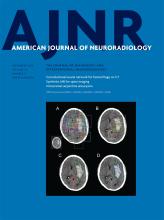Index by author
Shah-basak, P.
- FELLOWS' JOURNAL CLUBFunctionalYou have accessBreath-Hold Blood Oxygen Level–Dependent MRI: A Tool for the Assessment of Cerebrovascular Reserve in Children with Moyamoya DiseaseN. Dlamini, P. Shah-Basak, J. Leung, F. Kirkham, M. Shroff, A. Kassner, A. Robertson, P. Dirks, R. Westmacott, G. deVeber and W. LoganAmerican Journal of Neuroradiology September 2018, 39 (9) 1717-1723; DOI: https://doi.org/10.3174/ajnr.A5739
Twenty children (30 imaging sessions, 60 MR scans) with Moyamoya disease underwent dual breath-hold hypercapnic challenge blood oxygen level–dependent MR imaging of cerebrovascular reactivity studies in the same MR imaging session. Within-day, within-subject repeatability of cerebrovascular reactivity estimates, derived from the blood oxygen level–dependent signal, was computed. Breath-hold hypercapnic challenge blood oxygen level–dependent MR imaging is a repeatable technique for the assessment of cerebrovascular reactivity in children with Moyamoya disease and is reliably interpretable for use in clinical practice.
Shaibani, A.
- NeurointerventionYou have accessAdjunctive Efficacy of Intra-Arterial Conebeam CT Angiography Relative to DSA in the Diagnosis and Surgical Planning of Micro-Arteriovenous MalformationsA.S. Al-Smadi, A. Elmokadem, A. Shaibani, M.C. Hurley, M.B. Potts, B.S. Jahromi and S.A. AnsariAmerican Journal of Neuroradiology September 2018, 39 (9) 1689-1695; DOI: https://doi.org/10.3174/ajnr.A5745
Shapiro, M.
- NeurointerventionYou have accessToward a Better Understanding of Dural Arteriovenous Fistula Angioarchitecture: Superselective Transvenous Embolization of a Sigmoid Common Arterial CollectorM. Shapiro, E. Raz, M. Litao, T. Becske, H. Riina and P.K. NelsonAmerican Journal of Neuroradiology September 2018, 39 (9) 1682-1688; DOI: https://doi.org/10.3174/ajnr.A5740
Shin, J.
- FELLOWS' JOURNAL CLUBHead and Neck ImagingYou have accessContrast-Enhanced CISS Imaging for Evaluation of Neurovascular Compression in Trigeminal Neuralgia: Improved Correlation with Symptoms and Prediction of Surgical OutcomesA.M. Blitz, B. Northcutt, J. Shin, N. Aygun, D.A. Herzka, D. Theodros, C.R. Goodwin, M. Lim and D.P. SeeburgAmerican Journal of Neuroradiology September 2018, 39 (9) 1724-1732; DOI: https://doi.org/10.3174/ajnr.A5743
Retrospective review of high-resolution MRIs was performed in patients without prior microvascular decompression. 3D-CISS imaging without and with contrast for 81 patients with trigeminal neuralgia and 15 controls was intermixed and independently reviewed in a blinded fashion. Cisternal segments of both trigeminal nerves were assessed for the grade of neurovascular conflict, cross-sectional area, and degree of flattening. Contrast-enhanced CISS more than doubled the prevalence of the highest grade of neurovascular conflict (14.8% versus 33.3%) and yielded significantly lower cross-sectional area and greater degree of flattening for advanced-grade neurovascular conflict on the symptomatic side compared with non-contrast-enhanced CISS.
Shroff, M.
- FELLOWS' JOURNAL CLUBFunctionalYou have accessBreath-Hold Blood Oxygen Level–Dependent MRI: A Tool for the Assessment of Cerebrovascular Reserve in Children with Moyamoya DiseaseN. Dlamini, P. Shah-Basak, J. Leung, F. Kirkham, M. Shroff, A. Kassner, A. Robertson, P. Dirks, R. Westmacott, G. deVeber and W. LoganAmerican Journal of Neuroradiology September 2018, 39 (9) 1717-1723; DOI: https://doi.org/10.3174/ajnr.A5739
Twenty children (30 imaging sessions, 60 MR scans) with Moyamoya disease underwent dual breath-hold hypercapnic challenge blood oxygen level–dependent MR imaging of cerebrovascular reactivity studies in the same MR imaging session. Within-day, within-subject repeatability of cerebrovascular reactivity estimates, derived from the blood oxygen level–dependent signal, was computed. Breath-hold hypercapnic challenge blood oxygen level–dependent MR imaging is a repeatable technique for the assessment of cerebrovascular reactivity in children with Moyamoya disease and is reliably interpretable for use in clinical practice.
Skeete, D.
- You have accessReply:P. Nagpal, B.A. Policeni, M. Kwofie, G. Bathla, C.P. Derdeyn and D. SkeeteAmerican Journal of Neuroradiology September 2018, 39 (9) E104; DOI: https://doi.org/10.3174/ajnr.A5758
Sommer, C.M.
- NeurointerventionYou have accessInvestigation of a New Version of the Liquid Embolic Agent PHIL with Extra-Low-Viscosity in an Endovascular Embolization ModelD.F. Vollherbst, R. Otto, M. Hantz, C. Ulfert, H.U. Kauczor, M. Bendszus, C.M. Sommer and M.A. MöhlenbruchAmerican Journal of Neuroradiology September 2018, 39 (9) 1696-1702; DOI: https://doi.org/10.3174/ajnr.A5750
Song, J.
- NeurointerventionYou have accessFeasibility, Safety, and Periprocedural Complications Associated with Endovascular Treatment of Ruptured Intracranial Aneurysms according to the Depth of AnesthesiaJ. Song, C.-Y. Lee and H.-W. KimAmerican Journal of Neuroradiology September 2018, 39 (9) 1676-1681; DOI: https://doi.org/10.3174/ajnr.A5753
Spigos, D.
- You have accessMemorial: Galdino Valvassori, MD, FACRM. Mafee and D. SpigosAmerican Journal of Neuroradiology September 2018, 39 (9) E99; DOI: https://doi.org/10.3174/ajnr.A5716
Stern, M.
- Spine Imaging and Spine Image-Guided InterventionsYou have accessAssociation between Type 1 Modic Changes and Propionibacterium Acnes Infection in the Cervical Spine: An Observational StudyM.M. Georgy, F. Vaida, M. Stern and K. MurphyAmerican Journal of Neuroradiology September 2018, 39 (9) 1764-1767; DOI: https://doi.org/10.3174/ajnr.A5741








